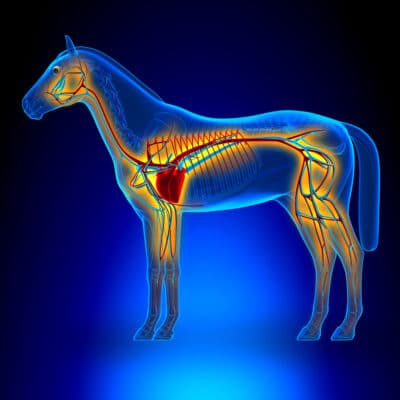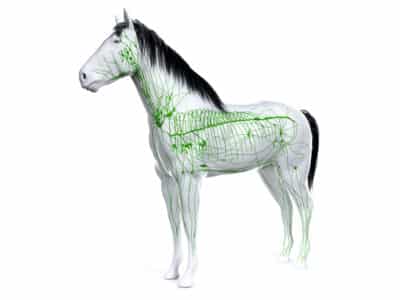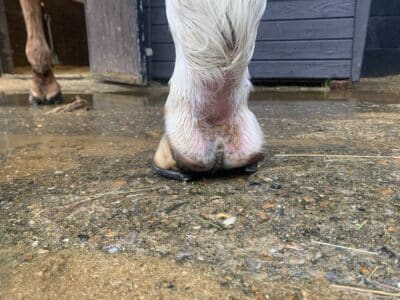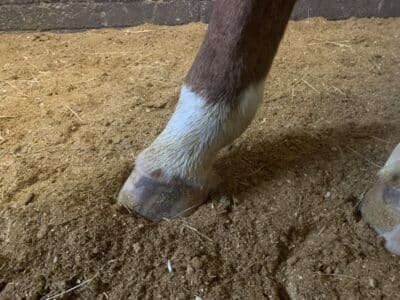Diseases & Conditions, Featured, Soft Tissue, Wound Care
Understanding Equine Lymphangitis
Rebecca Watson MSc RVN, discusses the causes, treatment and management of this difficult condition
Equine lymphangitis is a serious condition, which can reoccur and be frustrating for any horse owner to deal with. Affected horses are unable to work or perform and complications, such as cellulitis, can arise therefore, the recovery period can be lengthy.
The lymphatic system
When attempting to understand lymphangitis, it is important you know a bit about the lymphatic system, the way in which it functions, and the role it plays in the overall scheme of things relative to a horse’s health.
To better understand the lymphatic system, we must begin with the cardiovascular (CV) system. The CV system is considered a ‘closed system’ because all the blood vessels are connected to one another, with no vessel being ‘open-ended’ (otherwise the horse would be losing blood!) However, despite the closed nature of the CV system, there are ‘escape routes’ in the capillary blood vessels.

The capillaries, allow passage of liquids, such as plasma and serum, through their walls. While this process is a necessary part of the function of the circulatory system, it poses difficulties in the maintenance of the integrity of the system. Diffusion from the capillaries is accompanied by the loss of large quantities of liquid from the CV system. When blood passes through the capillaries, it loses more fluid to the body than it absorbs from it. If this fluid were not returned to the bloodstream, there would be serious consequences.
This is where the lymphatic system comes in to play, it is an ‘open’ circulatory system, and it is designed specifically to counteract the loss of fluid from the CV system and to return it back into the bloodstream. Lymphatic capillaries collect fluid from the body and return it to the CV circulation, through a series of lymphatic vessels.
While the heart is a key component of the CV system, it is not directly involved in moving fluid along or through the lymphatic vessels. Instead, fluid is driven through the lymphatic system when its vessels are squeezed by the movements of the body’s muscles. These lymphatic vessels contain a series of one-way valves that permit movement in only one direction, into the circulatory system.

While the main function of the lymphatic vessels is to gather water and macromolecules (eg. components of white blood cells) that leak from the capillaries, it also serves as the most direct route from the skin to draining lymph nodes. Which is where we see enlarged lymph nodes concurrent to infection or inflammatory disease.
When lymphatic flow in the skin is blocked for some reason, the interstitium or space between tissues, becomes overloaded with fluid, which causes limb swelling and ‘lymphangitis’. Consequently, there is impaired metabolism and an increased risk for the development of inflammatory skin disease, such as infectious lymphangitis or even cellulitis.
When we consider that 8% of the horse’s body mass is blood circulating through their bodies, the role played by the lymphatic system is very important.
Causative factors
While we do not understand exactly why equine lymphangitis occurs, we believe it may be associated with:
- A significant reduction in exercise. Muscle contraction is the typical force that moves lymph fluid back toward the CV system. The equine lower limb (below the knee or the hock) has no muscles to contract and, therefore, must rely on one-way valves in the lymphatic vessels and compression of the frog to propel lymph upwards.
- An old injury where there has been chronic swelling of the tissues in the limb, resulting in compromise of the circulatory system.
- A new injury or wound, either on the affected limb or elsewhere on the body and the resulting restriction of movement due to pain, which will compromise the circulatory system.
Presentation
Lymphangitis initially presents as a swollen limb, that is a similar temperature to touch, as the other, unaffected limbs. Depending on the severity of the swelling, there may or may not be associated lameness, but there is frequently compromise to the function of the limb, due to the swelling, resulting in a stiff or odd gait. The swollen limb will exhibit signs of oedematous ‘pitting’ (when you press a fingertip into the swollen tissue, the indentation will remain for a prolonged period of time). The horse may appear healthy otherwise.
If lymphangitis is not detected at an early stage, it can induce fever, as the condition progresses from inflammation to infection in the lymphatic system. If this happens the swelling may increase in size, the limb will become hot to touch and will be increasingly painful. These horses with an infectious lymphangitis are usually dull, lethargic and off their feed, due to the fever. In severe cases, leakage of an amber liquid can be seen through the skin (in particular at the front of the hock or the back of the knee or pastern). This leakage can cause scalding and further worsen the integrity of the skin. In these severe cases, this infectious lymphangitis can affect the internal layers of the skin and cause what is known as cellulitis.
If a horse is found with one leg swollen as described above, wash off the affected leg and carefully dry it, examining closely for any signs of cuts or abrasions. Confine the horse to a clean, dry stable and call your vet. Communicate the level of discomfort or pain the horse is in and ask for a full clinical evaluation of the horse at their earliest convenience. A horse presenting with an acute swollen limb may not necessarily be suffering from lymphangitis and other causes should be ruled out first.
Differential diagnoses include:
- Tendon sheath infection
- Joint infection
- Fracture
- Hoof abscess
- Cellulitis
- Sporotrichosis
While mud fever in itself may not be serious, when coupled with box rest be on the look out for swollen limbs that might be the first indication of something more serious
Management
A treatment plan will be dictated by your veterinary surgeon’s diagnosis. Do not, under any circumstances, give in to the temptation to administer any drugs (antibacterial or anti-inflammatory) to the horse before it is seen by a veterinary surgeon as this will only serve to hinder the diagnosis and may even prolong the recovery time. Prompt veterinary attention is key to a more successful outcome.
Mild cases of lymphangitis generally respond well to conservative symptomatic treatment of cold water therapy (cold hosing or ice buckets) and exercise. Be sure to dry the skin carefully after cold water therapy, as wet skin is more fragile and susceptible to damage.
More severe cases, with associated infectious agents, will require antimicrobial and anti-inflammatory treatment plans, which may include diuretics as well as cold water therapy / hydrotherapy and exercise, where pain is under control.
Bandaging will be indicated in some instances to help reduce the swelling in the limb, however, bandages may be contraindicated, as they may push the swelling up the limb, resulting in degradation of skin integrity higher up.
Likewise, massage therapy by a skilled practitioner, may be helpful where the skin is intact. But conversely, massage may make the situation worse. Remember the skin that has been stretched over a swollen limb is very fragile and susceptible to damage, which could worsen infection and increase recovery times.
Prevention
For recurrent cases, early detection and treatment of swelling can only help improve the outcome.
While the various treatment protocols may or may not be effective in treating lymphangitis in your horse, there is one factor that you can take control of – and that is cleanliness of the horse’s environment. Keeping stables in good, clean condition helps to minimise contamination of wounds, grazes or broken skin. Ensuring that paddocks are free of wire or other objects that could cause cuts or lacerations, or other such injuries will reduce the risk of problems.
The bad news is that any horse can contract lymphangitis even under the best of conditions. The fact remains (for the moment at least) that lymphangitis is a confusing malady that can side-line a horse for days, weeks, or even months. Severe or untreated cases can become chronic, and fibrosis and hardened spots on the legs can result.
The good news, and perhaps the reason so little has been done in the field of research, is that lymphangitis in the horse is a relatively uncommon affliction. However, horse owners should take all cases of a swollen ‘fat leg’ seriously and consult a veterinarian.
‘Good practice’ lymphangitis prevention measures:
- Wash off muddy legs and always dry them carefully afterwards
- Monitor limbs closely for cuts and grazes
- Treat any skin wounds as soon as you notice them
- Protect limbs when exercising – use boots
- Maintain good grooming kit hygiene – wash brushes regularly
- Maintain good stable hygiene
- Regularly patrol paddocks and remove debris which may cause injury
- For horses with long feathers; ensure mites are not an issue – self inflicted injuries due to scratching can contribute to the problem
- For horses that are prone to lymphangitis:
- try to keep them turned out 24/7
- if they must be stabled, consider stable bandages to control swelling
- ensure they get daily exercise
- consider supplementation to help support the circulatory syste
Related reading:
Help my horse has mud fever Hibiscrib – are you using it correctly What is elephant leg, cellulitis or lymphangitis in horses? Wet skin conditions


